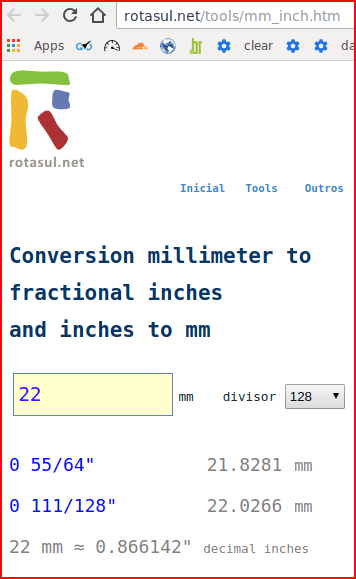Convert millimeter to fractional inches and inches to mm
just type a value, mm values just numbers and fractional inches values should include slash ( / ) or ( " )
How use this conversion calculator?

mm to in millimeter to fractional inches
just enter the metric (mm) value and choose the divisor i.e.:
9.5 mm in divisor 16
0 5/16″ 7.9375 mm
0 3/8″ 9.5250 mm
in to mm decimal inch to fraction of inch and millimeter
enter the value using double prime (″), i.e.:
1.25″ dec. inch divisor 16
1 1/4″ 31.7500 mm
To improve the approximation in fractional inches, set 512 in the divisor.
in to mm fraction of inches to millimeter
enter value with slash (/), i.e.:
1/8 frac. inches divisor 64
1/8″ 3.1750 mm
enter value with space and slash (/), i.e.:
1 1/4 frac. inches divisor 16
1 3/4″ 44.4500 mm
or enter the value using ( " ), space or slash ( / ), i.e.:
1″ 3/8 frac. inches divisor 16
1 3/8″ 34.9250 mm
mistakes, typos or crazy values are rounded to the best approximation, i.e.:
2 3/83 frac. inches divisor 128
2 1/32″ 51.5938 mm
2 5/128″ 51.7922 mm 
Limits
In practical terms it is rare to find denominators greater than 64. In these cases, the thousandth inch measurements "thousand" or "thou" (invented by Whitworth, the same as the threads) are more used and are equivalent to 1"/1000abbreviations:
thousandth > thou (UK)
mille > mil (USA)
even smaller:
tenths = thou / 10 = 0.0025 mm = 2.5 µm µm
The Metric System
The Metric System was officially created in France in 1790. By the advantages it has been adopted by many countries, currently only a few do not, which facilitates scientific work and trade relations.The Metric System uses 10 as divisor and the Imperial System uses 12 divisible by 2, 3, 4 and 6. In our daily lives is common the use of such fractions ( 1/4 pound, 3/4 gallon ...) as well as the use of some units such as the gallon in chemicals (1/4 = 900 mL), gold in ounces, construction steel gauges, tire sizes ( 14″ ), many screws are still marketed in inch and even the screens of televisions and phones released in inches.
Like other systems, the "Imperial" had some slight variations between the adopted standards, i.e.: an inch in England was not exactly the same as a Canadian inch and the Imperial gallon differed from the American gallon, these and other differences generated numerous technical-commercial problems. It was not until the late 1950s that the Imperial System was uniformed worldwide, and among other resolutions, the equivalence between millimeter and inch was established:
